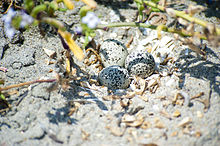- Snowy Plover
-
Snowy Plover 
Snowy Plover near Cayucos, California Conservation status Scientific classification Kingdom: Animalia Phylum: Chordata Class: Aves Order: Charadriiformes Family: Charadriidae Genus: Charadrius Species: C. nivosus Binomial name Charadrius nivosus
Cassin, 1858The Snowy Plover (Charadrius nivosus) is a small wader in the plover bird family. It breeds in Ecuador, Peru, Chile, the southern and western USA and the Caribbean. Although it was long considered to be a subspecies of the Kentish Plover, recent genetic research strongly suggests it should be regarded as a distinct species, and both the American Ornithologists' Union and the International Ornithological Congress recognise it as such.
Contents
Description
The Snowy Plover is 15–17 cm (5.9–6.7 in) long. It is smaller, paler, longer-legged and thinner-billed than Ringed Plover or Semipalmated Plover. Its breast band is never complete, and usually just appears as dark lateral patches on the sides of the breast. The Snowy Plover's upperparts are greyish brown and the underparts white in all plumages. The breast markings are black in summer adults, otherwise brown. Breeding males of some races have a black forehead bar and a black mask through the eye. The legs are black. In flight, the flight feathers are blackish with a strong white wing bar. The flight call is a sharp bip.
Taxonomy
Genetic research published in 2009 strongly suggested that the Snowy Plover is a separate species from the Kentish Plover,[1] and by July, 2011, the IOC, and the AOU North American committee have recognized them as separate species. Other taxonomic committees are reviewing the relationship.
Physically, Snowy Plovers are shorter-legged, paler and greyer above than its Old World sister species, and breeding males lack a rufous cap. The eyemask is also poorly developed or absent.
Reproduction
The Snowy Plover breeds on sandy coasts and brackish inland lakes, and is uncommon on fresh water. It nests in a ground scrape and lays three to five eggs. The breeding birds in warmer countries are largely sedentary, but northern and inland populations are migratory, wintering south to the tropics. Food is insects and other invertebrates, which are obtained by a run-and-pause technique, rather than the steady probing of some other wader groups.
The Western Snowy Plover breeds from Texas and Oklahoma west to California and up the coastline to Oregon and Washington, with the coastal form's primary breeding concentration in central and southern California.[2] The Pacific Coast population has been designated a Threatened species under the Endangered Species Act.
In many parts of the world, it had become difficult for this species to breed on beaches because of disturbance from the activities of humans or their animals. The University of California, Santa Barbara, is currently endeavoring to rehabilitate snowy plover populations by protecting beaches along the central California coastline that runs along part of the university campus.[3] UCSB has had some success in encouraging reproduction; the university also often trains students and other volunteers to watch over protected beaches during the daytime to ensure no one disturbs nesting grounds.
References
- ^ Clemens Küpper, Jakob Augustin, András Kosztolányi, Terry Burke, Jordy Figuerola, Tamás Székely (2009). "Kentish versus Snowy Plover: phenotypic and genetic analyses of Charadrius alexandrinus reveal divergence of Eurasian and American subspecies". The Auk (The American Ornithologists’ Union) 126 (4). http://www.bath.ac.uk/bio-sci/biodiversity-lab/publications/kupper_auk_2009.pdf.
- ^ "Recovery Plan for the Pacific Coast Population of the Western Snowy Plover (Charadrius nivosus nivosus)". U.S. Fish and Wildlife Service. http://www.fws.gov/arcata/es/birds/WSP/documents/RecoveryPlanWebRelease_09242007/WSP%20Final%20RP%2010-1-07.pdf. Retrieved 2009-10-01.
- ^ "2003 UCSB Press Release on snowy plovers". World Heritage. http://www.instadv.ucsb.edu/pa/display.aspx?pkey=1036. Retrieved 2007-05-21.
Bibliography
- Gill, F and D Donsker (Eds). 2011. IOC World Bird Names (version 2.9). Available at http://www.worldbirdnames.org/ [Accessed July 31, 2011].
- Chesser, R. Terry, Richard C. Banks, F. Keith Barker, Carla Cicero, Jon L. Dunn, Andrew W. Kratter, Irby J. Lovette, Pamela C. Rasmussen, J. V. Remsen, James D. Rising, Douglas F. Stotz, Kevin Winker. 2011. Fifty-second supplement to the American Ornithologists' Union Check-List of North American Birds. Auk 128(3):600-613.
External links
Categories:- Charadrius
- Shorebirds
- Birds of the United States
- Birds of Puerto Rico
Wikimedia Foundation. 2010.

